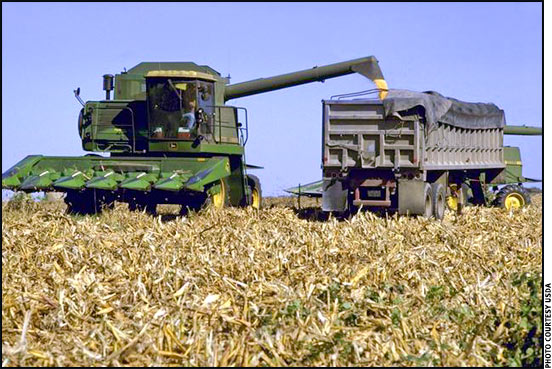
Manage Grain Quality from Harvest Through Storage
Consider four critical steps to maximizing corn quality after a challenging growing season.
The 2012 growing season has been synonymous with challenge. Many different faces of extreme weather have negatively affected the quantity and quality of corn that will be harvested this fall. While many of these factors alone can be detrimental to a corn crop, when they happen at the same time, the result can be a complete crop loss if not handled properly.
"This year has been particularly challenging for growers, as the drought has caused higher levels of mold in the corn being harvested," explains Gary Woodruff, Grain Conditioning Technology Manager with Grain Systems Incorporated (GSI). "Alongside the drought, warmer weather at harvest means the temperature inside the bin is higher than normal. When these two factors are combined, the spread of mold is exceptionally high and can translate to significant losses of stored corn and, ultimately, farmers' profits. Everyone putting grain in a bin must be vigilantly proactive this year to avoid devastating losses."
While the weather conditions can't be controlled, farmers must manage the environment in which the corn crop is harvested and stored, says Woodruff. To best manage this atypical season, he recommends the following tips to ensure the highest-quality grain can be marketed:
- 1. Dry quickly, cool quickly. Mold populations can grow 6% per hour at 80° F in the truck or wet bin. Woodruff recommends using a high-temperature dryer and raising the temperature to 120° F or higher, which significantly reduces the mold levels. Once dried, cool the grain as quickly as possible to 50° F or below for the best storability. Like a refrigerator, grain can be stored for much longer time periods when the temperature and moisture levels inside the bin are optimal. The table below shows the maximum amount of time corn can be stored (in days) based on grain temperature and moisture.
| Table 1: Maximum corn storage time (in days) based on moisture and temperature | ||||||||
| Temperature of grain, degrees F
|
Corn moisture content, %
|
|||||||
| 15
|
18
|
20
|
22
|
24
|
26
|
28
|
30
|
|
| 30 | * | * | * | 190 | 127 | 94 | 74 | 61 |
| 40 | * | 290 | 142 | 84 | 56 | 41 | 32 | 27 |
| 50 | * | 125 | 63 | 34 | 25 | 18 | 14 | 12 |
| 60 | 200 | 55 | 28 | 17 | 11 | 8 | 7 | 5 |
| 70 | 110 | 30 | 16 | 9 | 6 | 5 | 4 | 3 |
| 80 | 60 | 17 | 9 | 5 | 4 | 3 | 2 | 2 |
| *Allowable storage is greater than 300 days. | ||||||||
| Source: Brenneman G. Drying and Cooling Stored Grain and Preserving Its Quality. 2012 Grain Quality Conference, July 25, 2012. Decatur, Illinois; Slide 5. | ||||||||
- 2. Drop storage moisture percentage. Woodruff recommends dropping the storage moisture percentage by ½ to 1 percentage point this season, which means for many operations drying down to 14.5% or 14%. This helps to increase the length of time the grain can be stored, since lower moisture levels reduce mold growth. Do not consider trying to store grain above 14.5% moisture this year unless you are in an area where there was no drought and no mold issues.
- 3. Get corn out of the field fast. University experts are encouraging farmers to start harvesting earlier this growing season, harvesting at above 25% moisture, with some recommending starting as early as 30% moisture. Additional drying will be needed, which means a greater investment in fuel, but this can be justified, says Woodruff. He says growers will realize that the cost of 3-5 bushels (bu.) of corn can cover the additional fuel to dry an entire acre of grain at 25% harvest moisture. Field losses will escalate quickly as stalk quality declines, leaving many more bushels in the field.
- 4. Plan ahead for potential challenges. Woodruff warns that if you are unable to manage the corn crop with proper drying, cooling and storage practices, be prepared to take your grain quickly or even directly to the elevator. Marketing the corn quickly will allow it to be delivered to the elevator before the quality declines and the grain could possibly be rejected due to mold. If you have more bins than crop this year, consider still using them all, but reducing the grain depth. This improves the cooling and aeration rates and increases the chances of stopping a potential problem, while reducing the amount of grain lost if one bin has issues.
"Farmers put so much work into planning, planting and managing their crop throughout the growing season, and this fall we need to put as much focus on harvest and storage to reap the greatest benefits," says Woodruff.
Editor's Note: This article was provided as a news release by Grain Systems Incorporated, a manufacturer of steel farm bins, commercial storage grain bins, grain silos, grain dryers and material handling systems.











